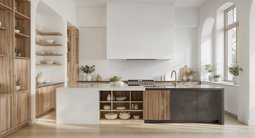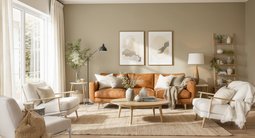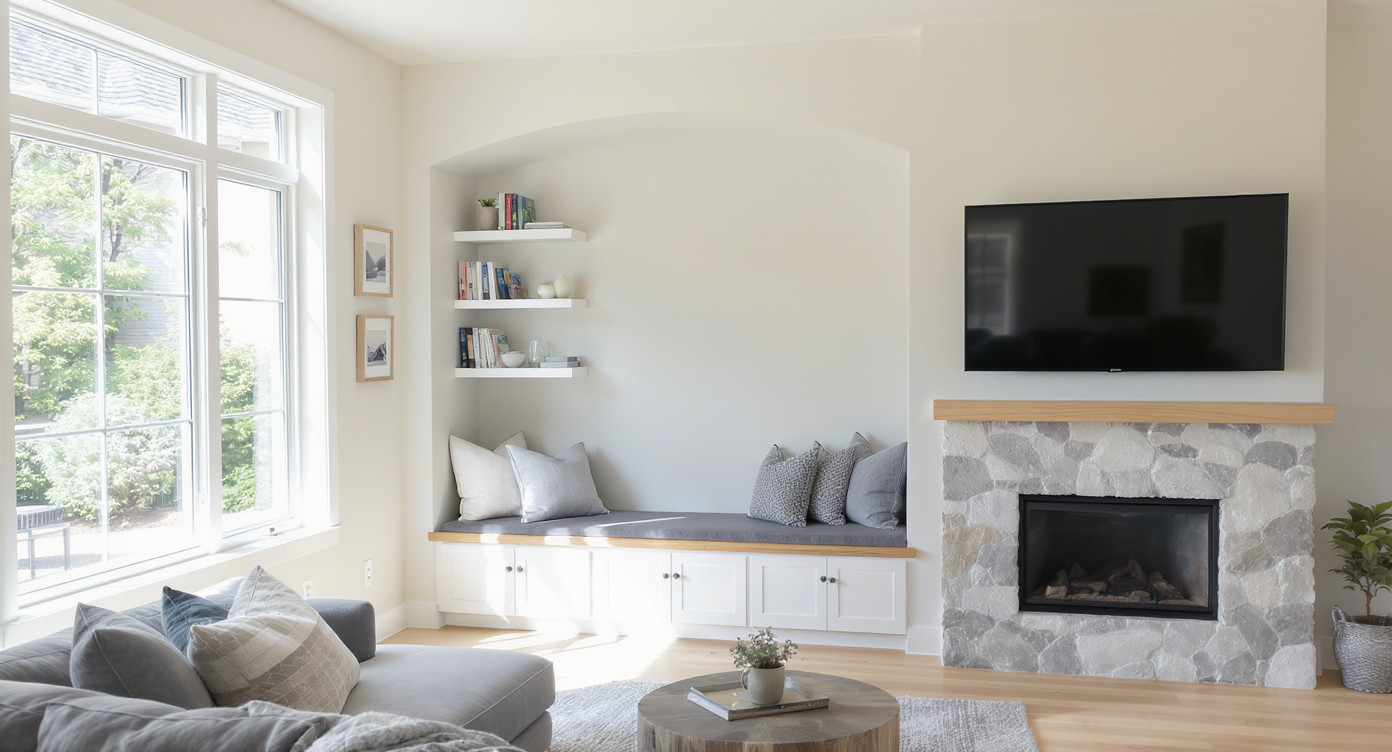TL;DR
In most living rooms, a shallow but wide nook is best used as a dedicated media center, bookshelf, or built-in bar—not as wasted space or an awkward perch for your TV above the fireplace. Placing the TV in the nook keeps it at comfortable eye-level and clears the fireplace for more attractive decor. Still, alternative options like built-in shelves, reading corners, or small workspaces can shine if media isn’t your main priority.
Why Does the Living Room Nook Feel So Unsolvable?

A shallow nook can become your living room’s standout feature with the right design approach.
Every homeowner or apartment renter seems to face it eventually—a curious little nook built into the living room, shallow but wide, brimming with design promise and equal parts indecision. One couple I spoke with recently summed it up well: he imagined a cozy reading bench paired with floating shelves, she only saw a perfect TV spot. They’d been politely sparring ever since the moving boxes hit the floor.
Debate swirls around what deserves pride of place: TV, books, art, or a statement bar setup? Meanwhile, the fireplace sits just off to the side, sparking its own controversy. Should the TV hover overhead, poised above the mantel, or live in that waiting alcove? You’re not alone in puzzling over this. A lot of living spaces include these design puzzles by intention—and with the right plan, you can turn yours into an everyday hero, not an eyesore or afterthought.
Turning an Awkward Nook into the Heart of Your Room
The most functional and attractive use for a shallow yet wide living room nook is almost always as a media center, integrated storage, or a creative built-in. While “put the TV over the fireplace” is a common suggestion, nearly every designer and living room veteran will pause you right there. Mounting a TV above a high fireplace typically results in uncomfortable neck craning, distracting glare, and, as one homeowner put it, “a guaranteed case of TV-too-high syndrome.”
Instead, aim to turn your living room nook into a natural hub. Place your TV at eye level within the alcove—using a sleek console or floating cabinetry for wires and media storage. Consider custom built-ins that combine closed cabinetry below (for devices, games, or less-lovely necessities) with elegant open shelving or display space above for books, art, or even a few cherished plants. If the TV isn’t the priority, the nook can become a dedicated bookcase, a compact workstation, or even a subtle dry bar for entertaining.
One homeowner confessed they ultimately “let the spouse win” with a TV-centered design, but they were surprised by how versatile—and tidy—it felt with proper shelving and storage flanking the screen. The fireplace? Freed up for a stunning print or sculptural mirror. Everyone got something to enjoy.
Anecdote
One homeowner admitted he was dead-set against a TV in the nook—until he agreed to it for the sake of marital peace. Weeks later, he realized the design felt deliberate and uncluttered, and having extra storage beneath the screen actually simplified life. His main advice? "Sometimes conceding on the small things makes the whole space better for everyone."
Classic Pitfalls to Dodge with Living Room Alcoves
- Mounting the TV above the fireplace: Visually appealing on Pinterest, but in practice, it’s usually too high for comfortable viewing. Most fireplaces are set higher than ideal TV height, leading to neck and eye strain and distracting heat or glare.
- Leaving the nook empty or cluttered: Many people freeze, turning it into a dumping ground or unused space. This makes the room feel unfinished.
- Ignoring plug and light location: Some spaces are pre-wired in the nook, practically begging to hold a media setup. One homeowner quipped that you “can’t unsee those outlets”—it would be a waste to ignore them.
- Lining the nook with random, mismatched furniture: Cramming in a desk, sideboard, or shelf that doesn’t quite fit often looks awkward. Built-ins are almost always better for shallow alcoves.
- Choosing the wrong sight lines: Positioning a TV or major piece of art where sunlight causes glare or across main walkways can make for daily frustration. Think about your room’s natural pathways before you commit.
Designers’ Secrets for Nook Success
Layered, built-in solutions almost always outperform one-off furniture in a tricky nook. If you go for a media setup, select cabinetry that offers closed storage for unsightly cables and components—some even come with velvet drawers to protect your remote collection.
For an extra dose of personality, flank the TV or shelves with a few plants or artwork, but keep clutter minimal. If you don’t need another screen, consider creating a mini library or bar. One designer I’ve worked with recently transformed a client’s alcove with glass shelving and soft lighting—a showstopper for evening cocktails without sacrificing daytime utility.
And here’s something from my own home: Our living room nook was once the most ignored corner in the house. After many design experiments, we finally fitted it with custom shelving in a warm finish, mixed in a few favorite books, a turntable, and a hidden charging station for devices. It’s where everyone ends up talking—proof that a well-designed nook draws people in, not just furniture.
Smart Tools & Inspiring Solutions
- Built-in Cabinetry or Modular Shelves: Custom or semi-custom solutions make the most of shallow dimensions.
- Media Consoles Designed for Alcoves: Look for low-profile units meant for tighter fits to maximize style and storage.
- Lighting Solutions: Add LED strips or small spotlights to highlight art, books, or the bar area.
- Digital Visualization Tools: If you want to picture every possibility before you commit, try an AI-powered tool like ReimagineHome for instant room simulations, mock-ups, and layout ideas. Seeing the options in full color helps sidestep regret.
Visualization Scenario
Picture this: Your living room, sunlight filtering softly across a built-in wall where your TV sits at the perfect height. Beneath it, discreet cabinets swallow up cables, remotes, and board games. To the sides: floating shelves showcasing stacked hardcovers and a trailing pothos, maybe a favorite framed photo. The fireplace is unblocked, now holding a beautiful piece of art. When guests walk in, they naturally drift toward the nook—drawn by its quiet order and welcoming vibe.
Your Living Room Nook Questions—Answered
- Should I put my TV above the fireplace or in the living room nook?
Usually, the nook is better. TVs above fireplaces are often too high and uncomfortable for viewing. - What if I don’t want a TV in the nook?
Consider custom shelving, a reading bench, or integrated cabinetry for books, art, or a compact bar setup. - How can I avoid the nook looking cluttered?
Choose closed cabinets for storage and limit shelf decor to a cohesive palette—less is more when working with shallow spaces. - What if there’s a window nearby that creates glare?
Install blinds or curtains, and angle the screen or shelves for optimal natural light without reflections. Anti-glare TV screens are another option. - Are built-ins necessary, or can I use ready-made furniture?
Bespoke built-ins maximize space and polish, but select furniture with tailored dimensions can work if built-ins bust the budget.
Finding Joy in Design Compromise
There’s no universal answer, but shallow living room nooks are rarely a waste. Whether you build a media hub, bookshelf, or just a cozy spot for your plants, the right approach comes from honestly assessing how you live. Sometimes, letting your partner’s preference lead (as one homeowner discovered) is the best compromise—especially if you reserve another corner for your favorite armchair or that cocktail set you’ve been eyeing.
In home design, every tricky space is a quiet invitation to get creative. Don’t settle for blank or awkward—make that nook work for you, and it just might become your favorite seat in the house.




.svg)

.svg)



.png)